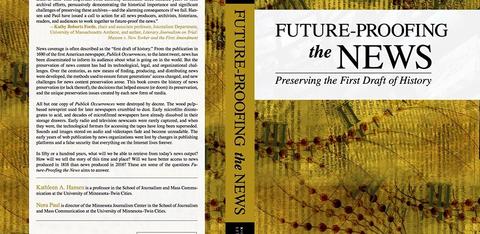Kathleen Hansen and Nora Paul uncover the haphazard history of American news annals.
Video killed the radio star, but did the Internet kill the news archive? SJMC professor Kathleen Hansen and Minnesota Journalism Center director Nora Paul tackle this question and others related to journalism technology changes in their new book, Future-Proofing the News, now available from Rowman & Littlefield.
Future-Proofing the News is the culmination of a quarter-century of academic friendship. Hansen and Paul have worked together since 1992 and have been colleagues at UMN since 2000, when Paul joined the SJMC faculty. They have published together on diverse digital media topics such as news gaming and computer-assisted research.
In their most recent joint effort, Hansen and Paul trace how technology changes have impacted the way journalism organizations save the first draft of history. By digging into news preservation strategies at newspapers, TV networks, radio stations and online publications, Hansen and Paul show that industry archival efforts have been sporadic at best and nonexistent at worst.
“The information age is an information black hole,” said Paul.
Throughout history, technology changes have created problems for news archivists, who may have stored broadsheets in newspapers’ libraries, for instance, but who may have altogether disregarded new forms of news transmissions, such as telegraphs or tweets. The lack of new technology archives creates problems for scholars and laypeople researching media history.
Hansen, who earned a master’s degree in library and information science at the University of Wisconsin, is especially interested in librarians’ role in news preservation. Unlike academic libraries, where scholarly documents are curated and stored in climate controlled vaults, news libraries faced issues of space, and news organizations questioned their relevance. Hansen heard tales that studios dumped nitrate newsreel film into the Santa Monica Bay in California and the East River in New York because fire-safe facilities were hard to come by.
Her research has shown that only a few news organizations, such as The New York Times, have funded libraries (and librarians) to preserve multimedia news content over the years. Elsewhere, news preservation efforts were left largely to hobbyists and collectors, who stored newsprint or audiovisual broadcasts in garages or basements across the country. These conditions are hardly ideal for sensitive newsprint and film.
“For every new method of creating and delivering content, there was no systematic decision made by anybody [regarding the archive],” said Hansen. “So whatever we have, it’s pretty much an accident.”
Future-Proofing The News walks readers through the inherent pitfalls associated with locating and accessing historical news content, as well as threats to contemporary news preservation. Hansen and Paul challenge journalists and mass communication scholars to think through the ways future generations will retrieve today’s news content.
